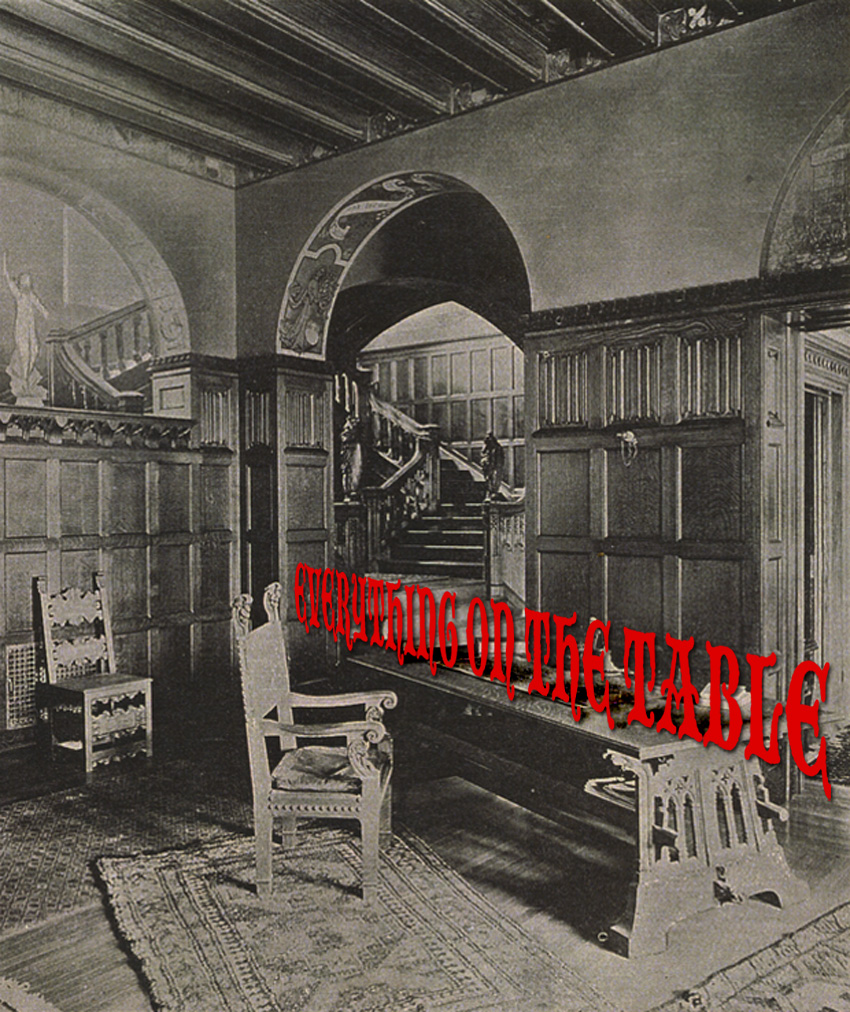
Will Price-designed table in John O. Gilmore’s Merion, PA house,Yorklynn, as published in an article about music rooms in American Homes and Gardens for March 1911
The workshops of the Rose Valley Shops, which produced furniture from 1901 until 1906, were located in architect William Lightfoot Price’s utopian experiment near Moylan, a suburb of Philadelphia, Pennsylvania. Price’s design vocabulary and the “structural theory” he employed at the Rose Valley Shops were fully formed years before production began in an old mill on Ridley Creek and he continued to design furniture after the workshops closed in 1906. It is difficult to reconcile Price’s rigorous version of the simple life as published in his magazine, The Artsman, with the grand and gaudy Chateauesque mansions he designed where furniture made in the Rose Valley Gothic style was sometimes placed alongside sharply contrasting plain furniture from the Gustav Stickley’s Craftsman factory. However, the Gothic style offered Price an opportunity to demonstrate his “structural idea” wherein the design of a piece of furniture was derived from the way it was constructed. In other words a table with a stretcher that ended with tenons extending through the table ends held in place by wedge-shaped pins actually comes apart as its design suggests.
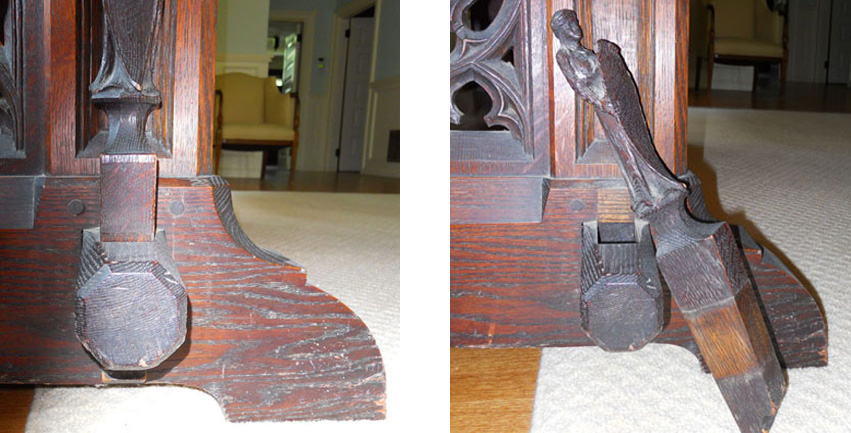
The carved pins on Rose Valley furniture are functional as well as decorative as demonstarted with one of the four figural pins on the Louis Clarke table.
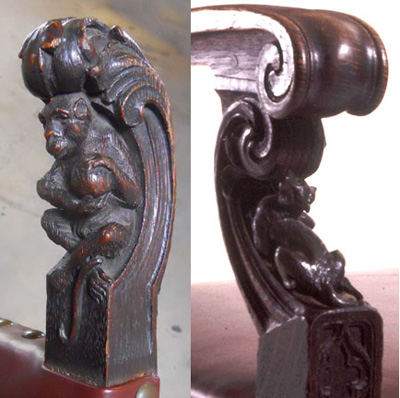
A suite of at least six armchairs with monkey finials and with lions crouched beneath the curling arms was ordered for John Gilmore’s Merion, PA house. The chairs originally had loose seat cushions made of tooled leather that matched the designs on the leather chair backs.

Years later I found the same images published in several magazines like House and Garden, for which Will Price was an editor. In those magazines the photographs were identified as being of the John O. Gilmore house, Yorklynne, built in Merion, Pennsylvania in 1899, two years before the workshops were established in Rose Valley. The photographs show much other furniture identifiable as designed by Price including a large trestle table. The Episcopal Academy bought Gilmore’s nineteen-acre estate (evidently to some extent furnished) for $225,000 in 1920; an intense battle to preserve the estate was lost in 1973 and the main house was demolished to make way for a parking lot. Snapshots taken just before the destruction show that some of the original furnishings remained in the house, so someone must have salvaged at least one armchair, which ended up a few years later in Roach’s shop. The large table in the period photographs (see title image) may not have passed on to the boys school.
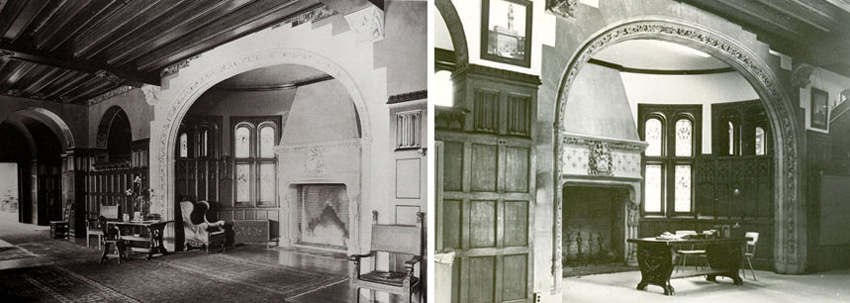
Yorklynne’s hall as it was furnished with Rose Valley pieces during the Gilmore family’s tenure is shown on the left. The armchairs are the same design as one I found in an antiques shop in the late 1970s. The table is probably the 36” X 48” design listed in the Price records as ordered by “Mr. Gilmore.” John Gilmore was known as the “Snuff King” because he was involved with the W. E. Garrett and Sons snuff company that had it’s mills in Yorklyn, Delaware; he was also a director and the first president of the Colonial Trust Company, which was formed in 1899, the same year as his house was built. There is another curious symmetry in the fact that the Rose Valley furniture workshops were established on the site of an old snuff mill.
The snapshot to the right shows the same hall just before the house was torn down in 1973. The table in front of the fireplace is probably part of the original furnishings, but it is not a Price production.
Many Price-designed library tables are known, but they usually have tops with modest dimensions like 44” X 28”or 48” X 36”, which are comparable to library tables manufactured by other makers (Standard Stickley Craftsman library tables average 48” X 30” although larger and smaller were available.) that were so fashionable at the turn of the last century. Price also designed a series of larger tables, each of which I once thought to be unique and custom-made for specific clients. That assumption has been proven wrong.

The George K. Crozer table was catalogue number 166 in “‘The Art That is Life’: The Arts & Crafts Movement in America, 1875-1920.” It is now on display at the Metropolitan Museum of Art. The top measures 66” X 40”.
Back in 1985 I acquired a large trestle table branded with the Rose Valley Shops mark at a Freeman auction in Philadelphia. At the time it was the grandest example of Rose Valley furniture known to exist and, as such, it was selected for inclusion in the landmark American Arts and Crafts exhibition, “The Art That is Life” (a Will Price quote I suggested) produced by Museum of Fine Arts, Boston in 1987. Catherine Hoover Voorsanger (1950-2001) acquired the table for the Metropolitan Museum of Art mostly because of the MFA,B bump. She developed a provenance that suggests George K. Crozer, Jr. of Philadelphia as the first owner. Years later, after the Price archives became available for study at the Athenaeum of Philadelphia, I discovered a pencil inscription giving Crozer’s name and address (2037 Delancy Street, Philadelphia) on an image of a table with the same distinctive pattern of the oak grain that is on the Met’s table. A letter from Crozer acknowledging receipt of the table, which was priced at $50, is dated April 1904. The same image was published in at least two period magazines. We assumed that the table was unique until last year when I was shown an identical signed table that was made for Louis Clarke’s house, which Price designed in 1901. More research revealed that there was another unidentified photograph showing the Clarke table. A photograph of the so-called Crozer table was pasted into an order book now in the Athenaeum’s collections above penciled names of clients who presumably ordered similar tables. Neither Crozer nor Clarke is on the list, but the scrapbook is undated and could have been started after these two tables were made. Another impressively large table made for J. King McLanahan, Sr. has/had more elaborately carved ends than the Crozer, Clarke, or Gilmore models..
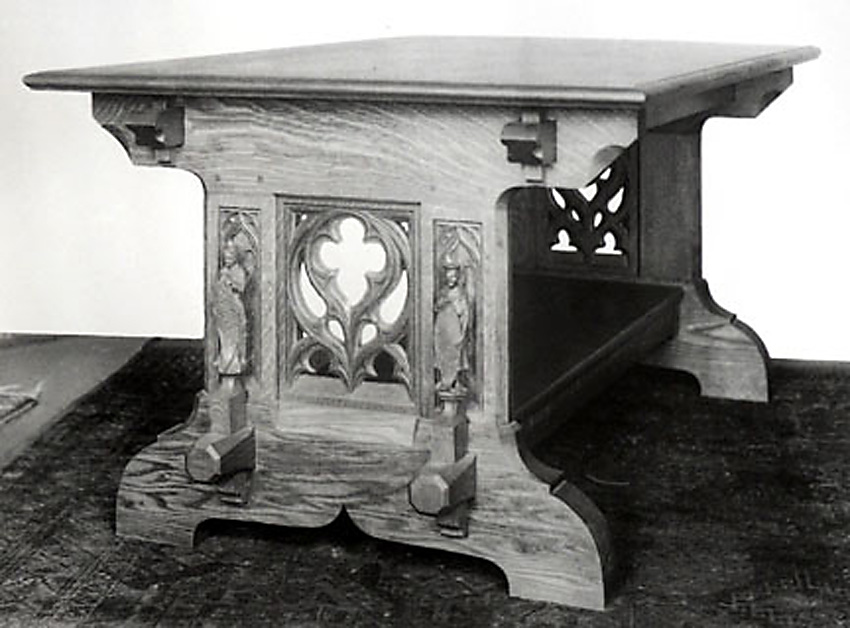
The grain pattern on the end of the table in the period photograph inscribed with George Crozer’s name identifies it as the table now in the permanent collections of the Metropolitan Museum of Art. The pattern also distinguishes this table from an identical table made for Louis Clarke.
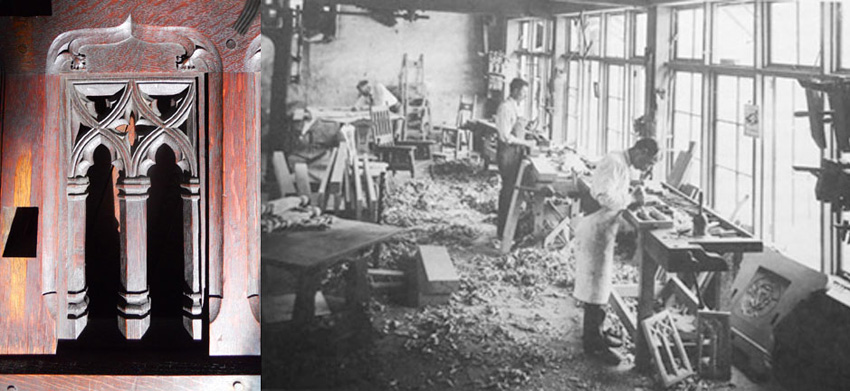
John Maene carves panels in front of a table end decorated with a huge Rose Valley logo while Will Price bends over a drawing table at the back of the furniture workshop in Rose Valley. The panels Maene is working on are identical to panels inset in the ends of a table found at an estate auction in Connecticut. Examples of all the furniture seen in this circa 1902 photograph except the logo table are known to exist today.
Price showed four chairs, a bench, and a table with carved ends at the St. Louis World’s Fair of 1904. Unfortunately the exposition catalogue description, “Gothic table of quartered white oak with carved panels framed in ends” gives no clue as to the design of the panels. My guess is that the panels might have been carved with the Rose Valley logo as an advertisement to induce fairgoers to place orders for the furniture. Parts of such a table are seen in a circa 1903 photograph of the workshops in the old mill in Rose Valley. Just in front of those table parts stands John Maene carving panels intended to be “framed in ends” of another large table. The three unfinished panels appear to be similar to a single panel remaining with Maene’s descendants; they are also the same design as the four panels framed into the ends of the table I found in Connecticut. The Connecticut table appears to be the same design as one made for John Gilmore’s Yorklynne, but I was unable to trace its provenance back to the Gilmore family. Gilmore is not among the names under the Crozer table in the order book, but a 36” X 48” table appears on a separate typed list of orders for 1900-1901 as “Mr. Gilmore’s table.” Gilmore might have taken delivery of more than one table because the top of the Connecticut table is 40” X 84”. Since no period photograph of that particular table found in the Price archives shows its grain-pattern “fingerprint,” I cannot be certain if the panels being carved in the workshop are those that were built into the Connecticut table or if the Connecticut table is in fact the same one that was once in Yorklynne.

Price used the same eagle corbels and the same grotesque masks carved on the trestle ends
on other tables, but the canted ends might be unique to the Gilmore design.
So far I know at least five large tables were actually made, but more research, more time and a little luck might add to that number.